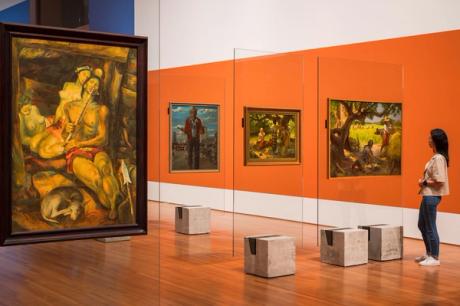
Discourse on Singapore’s place in the world often begins with its immediate neighbors in Southeast Asia and ends with its former colonizers and the wider Asian region. So for the 2024 edition of Singapore Art Week (SAW), two major exhibitions look closely at the conversations and parallels between Singapore, Southeast Asia and the Global South.
At the National Gallery Singapore (NGS), tropical delves into the modern history of Southeast Asia and Latin America and challenges their shared colonial narratives. These regions, as posited in Syed Hussein Alatas’ 1977 text The myth of the lazy native, contain more than bananas and parrots. Seven years in the making, this exhibition brings together around 200 works by more than 70 artists. It pulls a number of threads, including uses of textiles and embroidery and the similarities between Indonesia’s anti-colonial modernism and Diego Rivera’s statements about class. together with tropicalNGS is currently running the second of its series on early regional video arts, see you see you (until February 4).
African ties to Southeast Asia are explored Translations: Afro-Asian Poetics (January 18-30). Held at various locations in the Gillman Barracks gallery center, it is organized by Zoé Whitley and assistant curator Clara Che Wei Peh, at the invitation of the non-profit curatorial organization The Institutum. The show will see more than 100 artists from the two continents consider interconnected narratives about identity, migration and diaspora.
The two exhibitions provide a strong conceptual framework for a particularly lively 12th edition of SAW, centered on the flagship Art SG fair (January 18-21). This year, SAW has a record number of events and exhibitions, more than 150. A smaller boutique regional fair, SEA Focus (January 20-28), launched in 2019, also returns this year and will offer a showcase of regional artists. , such as FX Harsono and Yee I-Lann, brought by 22 galleries.
SEA Focus is once again being held at the maritime facility-turned-art venue Tanjong Pagar Distripark, which is also the temporary home of the Singapore Art Museum (SAM) while its main heritage site in the city center is being rebuilt. SAM welcomes local media star Ho Tze Nyuan this year with the mid-career survey Time and the tiger (until March 2, 2024). Nearby, Gajah Gallery presents an exhibition on colonial-era body language in Southeast Asia (until February 24).
Singapore has been in the news for attracting wealthy migrants from Hong Kong and mainland China, and this year sees a number of dealers, curators, collectors and media from greater China visit Singapore for the first time, or for the first time in many years, to investigate the buzz . Beijing-based collector Li Fan (also known as Lee Fan) opened a new private institution in Singapore on January 16, the Whale Museum, which currently exhibits art by Huang Yuxing and Ouyang Chun.
A handful of independent, artist-run spaces have also been founded in recent years, including Comma Space, which continues on January 19-21 with a series of symposiums on art and sustainability. Solo project by Angie Seah A room of your own continues through February 8 at Starch.
Gillman Barracks is bringing back its popular Art After Dark opening afternoons on January 20th and 27th. There, Richard Koh Fine Art is showing a political solo exhibition by Myanmar dissident artist Htien Lin, titled reincarnation (until January 27), which reflects on his recent time as a political prisoner after opposing his country’s military junta.
Yeo Workshop gallery shows new paintings by Filippo Sciascia (until 11 February). Its founder, Audrey Yeo, is currently the president of the Singapore Art Galleries Association, who has been strengthening SAW’s coordination and learning from other art weeks in Asia. “There have been big commitments for the city,” says Yeo, with collaborations with entities such as Valentino, Soho House, the Yenn and Alan Lo Foundation and the Mandala Club. “Our geographic location and political stability means that Singapore will always be a place that attracts an interesting mix of quality international expats who are keen and interested in cultural exchange and interactions, and I have personally been impressed by the growing scene of collectors here.”

